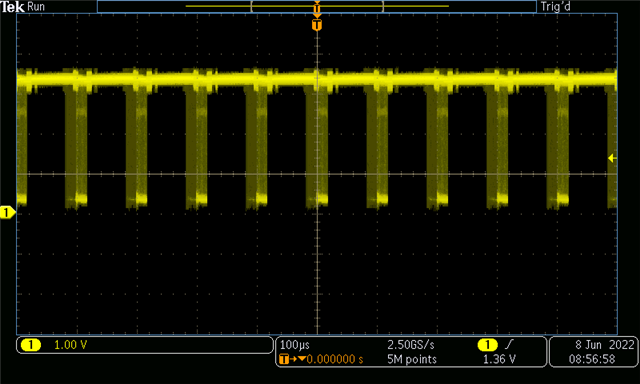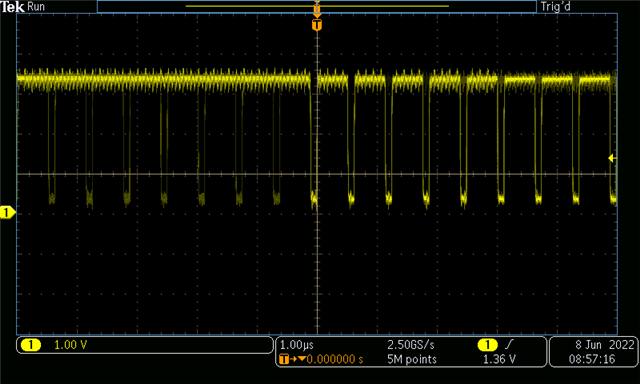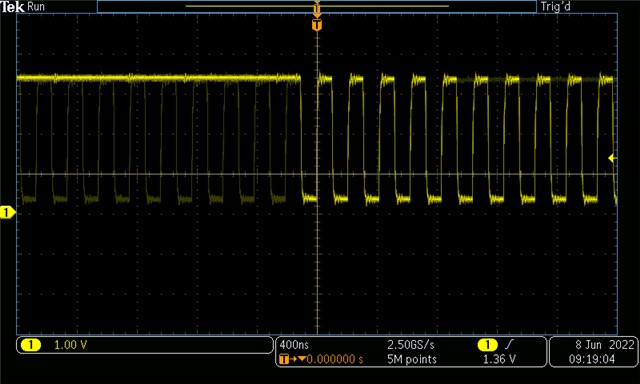各位专家、您好!
我正在探测 PJ.2以查看 ADC10CLK、波形不是预期的。 有什么想法为什么这么做?
1) 1)我不使用调试器。 (使用调试器之前 使8MHz MCLK 看起来很奇怪)
2) 2)在探测 J.0时、MCLK 看起来非常完美
3) 3) SMCLK 在探测 J.1时与 ADC10CLK 具有相同的奇数行为
4) 4)在缩小的范围捕获上看到抖动。
ADC10CLK (PJ.2)示波器捕捉已缩小:

放大的 ADC10CLK (PJ.2)示波器捕捉。 左半部分闪烁开/关:

随附相关代码:
// MSP430F51x2
// -----------------
// /|\| |
// | | |
// --|RST |
// GPIO to trip relay <-- (1)|P1.0 PJ.0 | (7) --> SMCLK (debug)
// AC + DC >---(2)|P1.1/A1 PJ.1 | (8) --> MCLK (debug)
// GPIO to debug TimerA <-- (4)|P1.3 PJ.2 | (9) --> ADC10CLK (debug)
PJSEL |= BIT0 + BIT1 + BIT2; //Output CLKs to PJ.0-2
PJDIR |= BIT0 + BIT1 + BIT2;
// configure clocks
UCSCTL3 = SELREF_2; // Set DCO FLL reference = REFO
UCSCTL4 |= SELA_2; // Set ACLK = REFO
__bis_SR_register(SCG0); // Disable the FLL control loop
UCSCTL0 = 0x0000; // Set lowest possible DCOx, MODx
UCSCTL1 = DCORSEL_5; // Select DCO range 16MHz operation
UCSCTL2 = FLLD_1 + 243; // Set DCO Multiplier for 8MHz
// (N + 1) * FLLRef = Fdco
// (243 + 1) * 32768 = 8MHz
__bic_SR_register(SCG0); // re-enable the FLL control loop
// Worst-case settling time for the DCO when the DCO range bits have been
// changed is n x 32 x 32 x f_MCLK / f_FLL_reference. See UCS chapter in 5xx
// UG for optimization.
// 32 x 32 x 8 MHz / 32,768 Hz = 250000 = MCLK cycles for DCO to settle
__delay_cycles(250000);
// Loop until XT1 & DCO stabilizes - In this case only DCO has to stabilize
do
{
UCSCTL7 &= ~(XT1LFOFFG + XT1HFOFFG + DCOFFG);
// Clear XT1,DCO fault flags
SFRIFG1 &= ~OFIFG; // Clear fault flags
}while (SFRIFG1&OFIFG); // Test oscillator fault flag
P1DIR |= BIT0 +BIT3; // Set P1.0, P1.3 output direction
P1OUT &= ~BIT0; // Clear P1.0
// Configure internal reference
while(REFCTL0 & REFGENBUSY); // If ref generator busy, WAIT
REFCTL0 |= REFVSEL_0+REFON; // Select internal ref = 1.5V
// Set FSR of ADC10 for ADC10SREF
__delay_cycles(100); // Delay for Ref to settle
// Configure ADC10
ADC10CTL0 &= ~ADC10ENC; // Disable ADC
ADC10CTL0 |= ADC10SHT_2; // clk cycles per sample period
ADC10CTL0 |= ADC10ON; // enable ADC10
ADC10CTL1 |= ADC10SSEL_0; // ADC clock = MODCLK = 5MHz
ADC10CTL1 |= ADC10SHP; // pulse sample mode
ADC10CTL1 |= ADC10CONSEQ_0; // single-conversion, single-channel mode 27.2.7
ADC10CTL1 |= ADC10SHS_0; // triggered sample with ADC10SC
ADC10CTL2 |= ADC10RES; // 10-bit conversion results
ADC10MCTL0 = 0;
ADC10MCTL0 |= ADC10SREF_1; // (REF_x) V+ = Vref+, V- = AVSS
ADC10MCTL0 |= ADC10INCH_1; // Read ch 1 (P1.1)
ADC10IE |= ADC10IFG0; // Interrupt enable
ADC10CTL0 |= ADC10ENC + ADC10SC; // Enable ADC and trigger ADC read



